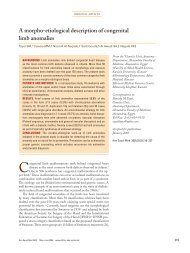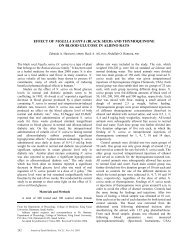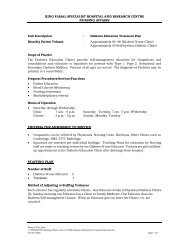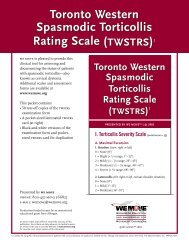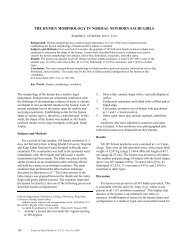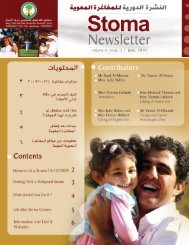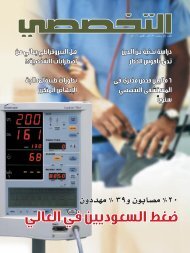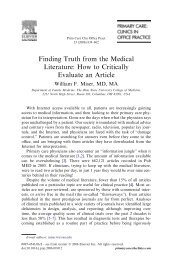ANAPLASTIC KI-1 (CD30) POSITIVE LARGE CELL LYMPHOMA OF ...
ANAPLASTIC KI-1 (CD30) POSITIVE LARGE CELL LYMPHOMA OF ...
ANAPLASTIC KI-1 (CD30) POSITIVE LARGE CELL LYMPHOMA OF ...
You also want an ePaper? Increase the reach of your titles
YUMPU automatically turns print PDFs into web optimized ePapers that Google loves.
<strong>ANAPLASTIC</strong> <strong>KI</strong>-1 (<strong>CD30</strong>) <strong>POSITIVE</strong> <strong>LARGE</strong> <strong>CELL</strong> <strong>LYMPHOMA</strong><strong>OF</strong> THE STOMACH MIMIC<strong>KI</strong>NG HODG<strong>KI</strong>N’S DISEASE:A CASE REPORT AND REVIEW <strong>OF</strong> THE LITERATUREMohammed B. Satti, FRCPath; Hassan Y. Al-Idrissi, MD, FACP; Mona H. Ismail, ABIM;Yusuf M. Gindan, MD; Abdulaziz A. Al-Quorain, MD, FACPThe stomach is considered the most common site ofprimary gastrointestinal lymphoma. 1 The majority of thesecases are classified as non-Hodgkin’s lymphoma (NHL), 1and with the recent adoption of the concept of mucosaassociatedlymphoid tissue (MALT), 2,3 they are nowclassified as low- and high-grade MALT-lymphomas. 4Primary Hodgkin’s disease of the gastrointestinal tract israre. 1,5,6-8 However, the stomach remains the most commonsite of primary extranodal gastrointestinal Hodgkin’sdisease. 6,9-11 The previously quoted figure of 9% as theproportion of Hodgkin’s disease relative to NHL involvingthe stomach 9 is controversial and too high. This iscertainly due to inclusion of such pleomorphic, anaplasticlymphomas as Hodgkin’s disease when a full panel ofimmunohistochemistry is not performed. Of all NHL, theone that usually mimics carcinoma or Hodgkin’s disease isthe anaplastic <strong>CD30</strong> (Ki-1) positive large cell lymphoma(ALCL), 12-18 which was included in the updated Kiel 19 andthe REAL classifications of lymphoid neoplasms. 20 Thecase presented here illustrates such morphologymisdiagnosed as Hodgkin’s disease.Materials and MethodsA 43-year-old Syrian male was admitted with a historyof upper abdominal pain and recurrent nausea andvomiting for the previous eight months. The pain waslocalized in the epigastrium, dull in character and wasaggravated by eating. There was no history ofhematemesis. He was having repeated episodes of melenaand had lost 16 kg body weight over the last four months.Past, family, social and personal history was notremarkable.Physical examination revealed a young male with signsof emaciation. He was pale but not jaundiced or cyanosed,and his vital signs were normal. Peripheral lymph nodesFrom the Departments of Pathology and Internal Medicine, King FaisalUniversity, Al-Khobar, Saudi Arabia.Address reprint requests and correspondence to Prof. Satti: Departmentof Pathology, King Faisal University, P.O. Box 40029, Al-Khobar 31952,Saudi Arabia.Accepted for publication 12 April 1999. Received 16 December 1998.were not palpable. Examination of the abdomen showed anill-defined mass in the epigastrium, 10x8 cm in size, nontenderwith irregular surface, and firm in consistency.Liver and spleen were not palpable and there was noascites.Laboratory investigations showed CBC hematocrit0.27, WBC 5.8x10 9 /L, hemoglobin 90 g/L, and peripheralblood smear and absolute indices suggestive of microcytichypochromic anemia. Total serum protein was 54 g/L,with serum albumin of 27 g/L. Liver enzymes and otherrelevant serum chemistry tests were normal.Upper GI endoscopy showed a fungating mass at thepre-pyloric area, with extension to mucosal folds andnarrowing of the lumen of the stomach. Multiple biopsieswere taken for histopathological examination. Theserevealed an anaplastic malignant neoplasm consistent withpoorly differentiated adenocarcinoma. No immunohistochemistrywas performed. CT scan of the abdomenrevealed thickened gastric pylorus with polypoidalprojections from its wall (Figure 1). A small oval softtissue mass was seen just underneath the anteriorabdominal wall close to the region of pylorus. Pancreas,spleen, liver, kidneys and adrenals were normal and therewas no para-aortic lymphadenopathy.Upon the diagnosis of gastric malignancy, the patientwas posted for surgery. The intraoperative findings were alarge gastric tumor in the antrum infiltrating up to theserosa of the stomach, with an enlarged lymph node at thegreater curvature just proximal to the pylorus, and aprominent pancreatoduodenal lymph node. The liver wasnormal and there was no ascites. Partial gastrectomy withend-to-side retrocolic gastrojejunostomy was done.Pancreatoduodenal lymph node was excised. The specimenwas fixed in 10% buffered formaldehyde. Paraffin sectionswere prepared and examined using routine hematoxylinand eosin (H&E) stain.In 1998, immunohistochemistry was performed onsections retrieved from formalin-fixed paraffin blocksusing an avidin-biotin-peroxidase complex method, 21utilizing the microwave for antigen retrieval. A panel ofmonoclonal antibodies against Ber-H2/<strong>CD30</strong> (Dako), LeuMI/CD15 (Becton Dickinson), LCA/CD45 (Dako), UCHL-1/CD45RO (Dako), L26/CD20 (Dako), KP1/CD68 (Dako),352 Annals of Saudi Medicine, Vol 19, No 4, 1999
CASE REPORT: <strong>ANAPLASTIC</strong> <strong>LARGE</strong> <strong>CELL</strong> <strong>LYMPHOMA</strong>E29/EMA (Dako), CD3 (Dako), Vimentin (Dako), andAEI-AE3 Cytokeratin (Boehringer Mannheim) wasperformed.ResultsGross examination of the partially resected 12x7x4 cmstomach revealed an exophytic 5x4 cm gastric tumor,which was infiltrating up to the serosa and had a fish-fleshgray-white cut surface. The resection margins were free ofthe tumor. Several perigastric lymph nodes submitted alsoshowed fish-flesh homogenous appearance.In 1994, based on the anaplastic morphology of thegastric neoplasm, the presence of Reed-Sternberg-like (R-S-like) cells and a negative cytokeratin on immunohistochemistry,a diagnosis of Hodgkin’s disease of thestomach was given. Based on this diagnosis, therapy wasstarted.Review of the case in 1998 in a retrospective study ofgastric malignancies revealed a gastric tumor with surfaceulceration of a mucosal neoplasm that extended deep intothe wall and serosa. The tumor was formed of sheets ofpleomorphic cells, with small and large embryo-likemultilobated nuclei having prominent nucleoli andabundant cytoplasm (Figure 2). A variable proportion ofsmall lymphocytic cells were seen, but eosinophils andneutrophils were very scanty. A few binucleate R-S-likecells were seen (Figure 3), in addition to rare cells withbizarre wreath-like multilobated nuclei. A transitionbetween the relatively small-size tumor cells and the largermultinucleated cells was always observed. The lymphnodes showed the same histology with a sinus, carcinomalikepattern of involvement being very apparent (Figure 4).The majority of the neoplastic cells, including the giantR-S-like forms, reacted positively for <strong>CD30</strong> in amembrane- and dot-like pattern and negatively for CD15antibodies (Figure 5). They were also positive for CD45,vimentin and focally positive for EMA. Reaction for T-cellCD45RO and CD3 was negative, while a few tumor cellsreacted positively for B-cells CD20 antibodies. Thepancytokeratin marker AE1-AE3 was negative in thetumor cells. The pleomorphic morphology of this lymphoidneoplasm, the sheet-like and sinus pattern of involvementof lymph nodes, combined with the immunohistochemicalreaction of the tumor cells, reclassifies this neoplasm asprimary gastric <strong>CD30</strong> (Ki-1)-positive ALCL stage II (IE),due to perigastric lymph node involvement. In situhybridization for EBV mRNA was not performed.The postoperative course was uneventful. Subsequentbone marrow aspiration did not show evidence oflymphomatous infiltration. Chemotherapy was started andthe patient received 6 cycles of COPP and ABVD monthlyon an alternate basis over six months. Uppergastrointestinal endoscopy done eight months after surgerywas normal. Biopsies obtained through endoscopy showedfocal collections of plasma cells and eosinophils with areasof intestinal metaplasia, but no evidence of recurrent orresidual malignancy. Repeat CT scan of the abdomenshortly after the endoscopy showed normal stomach. Therewas no evidence of para-aortic lymph node enlargement.At the latest follow-up in February 1998, almost four yearsafter the diagnosis, the patient was alive and well with noevidence of residual tumor, clinically or at endoscopy.DiscussionPresentation of Hodgkin’s disease (HD) as a localizedextranodal process unassociated with lymphatic tissueinvolvement is quite rare, occurring in less than 1% ofpatients with HD. 5 In the NCI study, 6 only six patientswith a histologically reconfirmed diagnosis of HD wereidentified during the period 1953-1990. Of all six cases,however, four involved the stomach. Such a rare diagnosisshould, therefore, be confirmed by combined classichistopathologic and immunophenotypic features. 7,8,10,11This is supported by the fact that in several retrospectivestudies the cases that were originally diagnosed as HDwere all re-classified as NHL of a large cell type after reexamination.9,22 Therefore, the predominant gastriclymphoid malignancy is NHL, 1,4 which has increased infrequency, in contrast to gastric carcinoma, which hasshown a decline in both incidence and mortality rates overthe past few decades. 23,24 These lymphomas were originallyclassified according to criteria developed for nodallymphomas. 25,26 However, with the recent adoption of theconcept of MALT, 2,3 most of these lymphomas have beenclassified as low- and high-grade MALT-lymphomas, 4characterized by the presence of lymphoepithelial lesions(LEL). Only 12 of the 60 cases reported by Hsi et al. 4lacked LEL and were thus classified as diffuse large celllymphomas (DLCL). Some of these gastric DLCL mayassume a pleomorphic anaplastic morphology, with sheetlikegrowth pattern that may simulate carcinoma 12 andFIGURE 1. CT scan of the abdomen, showing thickened gastric pyloricregion with polypoidal projections from its wall.Annals of Saudi Medicine, Vol 19, No 4, 1999 353
SATTI ET ALFIGURE 2. Sheet of anaplastic cells with pleomorphic nuclei havingprominent nucleoli in the stomach mucosa (H&E, 125x).FIGURE 3. Scattered cells with embryo-like nuclei having prominentnucleoli and multinucleated R-S-like cells with prominent eosinophilicnucleoli (H&E , 275x).FIGURE 4. Sinus and paracortical involvement of lymph node with sheetlikepattern of growth of neoplastic cells (carcinoma-like) (H&E, 125x).may also contain cells with large multilobated nuclei, R-Slike,that may give rise to a false diagnosis of HD. 17 Someof the large cell lymphomas with such morphology arecharacterized by being <strong>CD30</strong>-positive and are recognizedmostly at nodal sites, 15,17,18 but also at extranodalsites. 12,13,16 In the study of Hsi et al., 4 however,immunohistochemistry for <strong>CD30</strong> was not included amongthe panel of antibodies used. These lymphomas are nowincluded in the updated Kiel classification, 19 as well as theREAL classification of lymphoid neoplasms. 20 Primary<strong>CD30</strong>-positive ALCL of stomach are very rare. 12,13,27,28 Inour patient, a diagnosis of ALCL <strong>CD30</strong>+ was made, wherethe tumor cells were arranged in sheets, having abundantfaintly eosinophilic cytoplasm and large nuclei withprominent eosinophilic nucleoli. A variable proportion oflarge, bizarre, often multinucleated, cells in a backgroundof small lymphocytes raised the possibility of HD.However, these cells reacted positively for Ber H2/<strong>CD30</strong>and negatively with antibodies to Leu MI/CD15.FIGURE 5. Membrane and dot-like pattern of immunostaining in tumorcells, including the R-S-like cells. Immunohistochemistry for BerH2/<strong>CD30</strong>x275.Furthermore, co-expression in our case of LCA/CD45 andEMA practically ruled out HD. 13,29,30 However, in situhybridization for EBV mRNA was not performed tofurther support this contention. Vimentin was positive inall tumor cells, as noted previously. 13,17,31 The sinus patternof involvement in lymph nodes raises the possibility ofcarcinoma excluded by the negative cytokeratin reaction. 31Most of the <strong>CD30</strong>-positive ALCL were of T-cell or nullcell lineage. 12,15,18 However, our case showed tumor cellspositive for B cell L26/CD20, similar to the report of Paulliet al., 13 where three cases out of six were of B-cell lineage.It must, however, be pointed out that <strong>CD30</strong> defines alymphocyte activation antigen and is expressed by R-Scells and some non-lymphoid neoplasms. 14,32The stomach is the most common site of primaryextranodal lymphomas in adults. 24 Our case conforms withcriteria set for the diagnosis of primary gastric lymphomas,defined as malignant lymphomas, in which the presentingsigns/symptoms are referable to the gastrointestinal tract,354 Annals of Saudi Medicine, Vol 19, No 4, 1999
CASE REPORT: <strong>ANAPLASTIC</strong> <strong>LARGE</strong> <strong>CELL</strong> <strong>LYMPHOMA</strong>with the major tumor burden located in the stomach. 4 In aprevious publication, Dawson et al. 33 proposed a set ofcriteria for the diagnosis of primary gastrointestinallymphomas, including: 1) absence of peripherallymphadenopathy at the time of presentation; 2) lack ofenlarged mediastinal lymph nodes on chest x-ray; 3) anormal total WBC and differential; 4) predominance of thebowel lesion at the time of laparatomy with the only lymphnodes obviously affected being those in its immediateneighborhood; and 5) the liver and spleen not showing anylymphomatous involvement. Our present case fulfills allthese criteria.The prognosis of patients with <strong>CD30</strong>+ ALCL isreported to be poor, with an overall median survival of 13months, 15 except for the primary cutaneous form, whichhas a favorable prognosis, with an overall median survivalof 42 months. These figures might raise doubt about thediagnosis in our patient, who was free of disease for almostfour years post-treatment. However, the age (
SATTI ET ALA revised European-American classification of lymphoid neoplasms: aproposal from the International Lymphoma Study Group. Blood1994;84:1361-92.21. Hsu SM, Raine L, Fanger H. Use of avidin-biotin-peroxidase complex(ABC) in immunoperoxidase techniques: a comparison between ABCand unlabelled antibody (PAP) procedures. J Histochem Cytochem1981;29:577-80.22. Kristin H, Farrer-Brown G. Primary lymphomas of the gastrointestinaltract. 1. Plasma cell tumors. Histopathology 1977;1:53-76.23. Davils DL, Hoel D, Fox J, Lopez A. International trends in cancermortality in France, Western Germany, Italy, England and Wales andthe USA. Lancet 1990;i:474-81.24. Severson RK, Davis S. Increasing incidence of primary gastriclymphoma. Cancer 1990;66:1283-7.25. The non-Hodgkin’s lymphoma pathologic classification project.National Cancer Institute sponsored study of classification of non-Hodgkin’s lymphomas. Summary and description of a workingformulation for clinical usage. Cancer 1982;49:2112-35.26. Lukes RJ, Collins RD. Immunologic characterization of humanmalignant lymphomas. Cancer 1994;34(Suppl):1488-503.27. Chan JKC, Ng CS, Hui PK, Leung TW, Lo ESF, Lau WH, et al.Anaplastic large cell Ki-1 lymphoma: delineation of two morphologicaltypes. Histopathology 1989;15:11-34.28. Agnarsson BA, Kadin ME. Ki-1 positive large cell lymphoma: amorphologic and immunologic study of 19 cases. Am J Surg Pathol1988;12:264-74.29. Delsol G, Stein H, Pulford KAF, Gatter KC, Erber WN, Zinne K, et al.Human lymphoid cells express epithelial membrane antigen:implications of diagnosis of human neoplasms. Lancet 1984;ii:1124-8.30. Nicholas DS, Harris S, Wright DH. Lymphocyte predominanceHodgkin’s disease: an immunohistochemical study. Histopathology1990;16:157-65.31. Gustmann C, Altmannsberger M, Osborn M, Griesser H, Feller AC.Cytokeratin expression and vimentin content in large cell anaplasticlymphomas and other non-Hodgkin’s lymphomas. Am J Pathol1991;138:1413-22.32. Pallesen G, Hamilton-Dutoit SJ. Ki-1 (CD 30) antigen is regularlyexpressed by tumor cells of embryonal carcinoma. Am J Pathol1988;133:446-50.33. Dawson IMP, Corners JS, Morson BC. Primary malignant lymphoidtumors of the intestinal tract: report of 37 cases with a study of factorsinfluencing prognosis. Br J Surg 1961;49:80-9.34. Nakamura S, Akazawa K, Yao T, Tsuneyoshi M. Primary gastriclymphoma: a clinicopathologic study of 233 cases with special referenceto evaluation with the MIB-1 index. Cancer 1995;76:1313-24.35. Shiota M, Fujimoto J, Takenaga M, Satoh H, Ichinohasama R, Abe M,et al. Diagnosis of t (2;5) (p 23; q35)-associated Ki-1 lymphoma withimmunohistochemistry. Blood 1994;84:3648-52.356 Annals of Saudi Medicine, Vol 19, No 4, 1999



